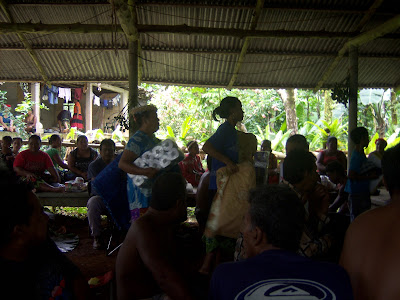Let me walk you through a typical Pohnpeian feast, or
kamadipw.
Here’s the setup: Feast season in Pohnpei coincides with the
harvest of yams, normally starting in September and running through
November. Feasts are entire village
celebrations of the traditional leaders and of the harvest. Food, dancing, and sakau abound. There are two major feasts Pohnpeian villages
can have. The most important one is the kamadipw en wahu, the feast for the Nahnmwarki (king) of the municipality,
of which Pohnpei has six. I happen to
live in the most populated municipality, Madolenihmw, where its Nahnmwarki is considered the highest
ranking in all of Pohnpei. So, if you
can imagine, feasts get pretty intense.
The second most important is the kamadipw
en kousapw, the feast a Pohnpeian village has to celebrate its Soumas (village chief). My village, Deleur, recently held its kamadipw en kousapw. It’s a small village, populated by 50 or so
people. However, that does not mean its
feast had to be small.
Since my pahpa and
nohno have high traditional titles,
they are always expected to provide a lot for their village feasts. Actually, everybody who attends a feast is
expected to bring something to share because they will get something in return
(except crazy mehn wai who normally
have no idea what is going on). This is
no problem because Pohnpei has such a communalistic, collectivistic
culture. Everyone is ALWAYS willing to
share what they have for the benefit of all.
Moving on…a day before the feast my host family and I went to town to
buy food for making numerous trays (including rice, chicken, hotdogs, juice,
snacks) and gifts to pass out (like shirts, mwaramwars,
fabrics).
 |
| The day of the feast, my nohno and host sister got up at 3AM (!) to cook all of the food and prepare the trays to bring |
 |
My pahpa also went
out to buy a pig that would be one of many to be butchered, roasted, and passed
out to the feast-goers
|
Since this feast was in walking distance of my house, I was
driven there half way and walked the other half (don’t judge). You can tell how long a feast has been going
on by the amount of people, pigs, yams, and sakau pounding you can see and
hear.
 |
| The main part of a feast is held in the nahs.
Yes, that is a dead dog. |
 |
| Here’s where the pigs are cooked. |
 |
| No feast is complete without music… |
 |
| …or sakau. |
 |
Look at all those yams!
|
 |
| Just a small sampling of trays that would be given
away at lunch time. |
As token mehn wai
and host daughter of high titled parents, I am normally made to sit in the nahs
with other women. It’s a place of honor,
but also a place where I won’t get in the way of anything. From my vantage point I could see pretty much
everything of importance.
 |
| The traditional leaders being honored sit in the
front of the nahs. |
 |
| The pounding and drinking of sakau goes on for the
entire length of the feast. |
 |
| Once the dancing starts it doesn’t stop! |
First gifts are brought up to the front then passed back
out.
 |
The MC (the guy standing up without his shirt on)
dictates the pace of the events.
|
 |
| Food preparations are done entirely by women. |
 |
| The village Soumas giving a speech thanking everyone
for coming. |
Next comes the passing of the food. The MC first calls out the titles of those
highest ranking who get the biggest and best trays. Then all of the food is gradually passed out to
everyone else.
 |
| Female food
line! |
 |
| My nohno
is the one in the black and red shirt putting trays in the nahs. |
After we all eat, we watch the entertainment in the form of organized
dances and speeches given by prominent community members.
 |
| My little host sister (purple) and student (red) had
dance practices for a week. |
 |
| The
Principal of a local elementary school reminding everyone that they need to
take responsibility for Pohnpei’s future and not rely solely on U.S.
funds. |
Last is the giving and taking of sakau, yams, gifts, and pig
parts
 |
| Sakau
plants being brought up |
 |
| My host sister (purple) participated in passing
some of the gifts out. |
 |
| The Soumas really got into the swing of
things! |
 |
| Yes, those
pigs are indeed flayed open. |
 |
| Bonus visit by the Governor of Pohnpei! |
 |
| My pahpa
(purple) helped decide the people in which to pass out the pig parts to |
Feasts are fun but rather tiring events. I even danced a bit at this feast (sorry, no
evidence). If you, dear reader, ever
come to Pohnpei make sure you attend at least one of these kamadipws! You will surely
be expected to dance but you will definitely have a good time.
 |
| The day after. |



























Pictures speak louder than words!!!! What else can I say...as awestruck and thrilled as I am... learning a lot about Micronesian Culture through your eyes and experiences....Bravo Janelle!!!
ReplyDeleteJanelle! This post made me homesick for Madolenihmw (the emotional kind of homesick, haha). Good work!
ReplyDelete-Mollie